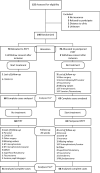Pelvic floor physical therapy in patients with chronic anal fissure: a randomized controlled trial
- PMID: 35511322
- PMCID: PMC9069957
- DOI: 10.1007/s10151-022-02618-9
Pelvic floor physical therapy in patients with chronic anal fissure: a randomized controlled trial
Abstract
Background: A chronic anal fissure is a common, painful condition with great impact on daily life. The exact pathogenesis has not been fully elucidated and treatment varies. A large percentage of patients experience pelvic floor dysfunction (dyssynergia and increased pelvic floor muscle tone). The aim of our study was to investigate the effect of pelvic floor physical therapy in patients with chronic anal fissure.
Methods: Between December 2018 and July 2021, at the Proctos Clinic in the Netherlands, patients with chronic anal fissure and pelvic floor dysfunction were randomly assigned to an intervention group, receiving 8 weeks of pelvic floor physical therapy including electromyographic biofeedback or assigned to a control group receiving postponed pelvic floor physical therapy. The primary outcome was muscle tone at rest during electromyographic registration of the pelvic floor before and after pelvic floor physical therapy. Secondary outcomes contained healing of the fissure, pain ratings, improvement of pelvic floor function, and complaint reduction measured with a proctology-specific patient-reported outcome measurement. Endpoints were measured at 8- and 20-week follow-up.
Results: One hundred forty patients were included in the study, 68 men (48.6%) and 72 women (51.4%) with a mean age of 44.5 ± 11.1 (range 19-79) years. Mean resting electromyographic values of the pelvic floor in the intervention group significantly improved from pre- to post-treatment (p < 0.001) and relative to controls (mean estimated difference between groups - 1.88 µV; 95% CI, - 2.49 to - 1.27 (p < 0.001) at first follow-up and remained significant from baseline at 20-week follow-up (p < 0.001). The intervention group performed better compared to the control group on all secondary outcomes, i.e., healing of the fissure (55.7% of the patients vs 21.4% in control, pain ratings (p < 0.001), diminished dyssynergia (p < 0.001), complaint reduction (p < 0.001), and decrease of pelvic floor muscle tone (p < 0.05) at first follow-up.
Conclusions: The findings of this study provide strong evidence that pelvic floor physical therapy is effective in patients with chronic anal fissure and pelvic floor dysfunction and supports its recommendation as adjuvant treatment besides regular conservative treatment.
Keywords: Anal pain; Biofeedback; Chronic anal fissure; Pelvic floor physical therapy; Treatment.
© 2022. The Author(s).
Conflict of interest statement
The authors declare that they have neither competing interests nor conflict of interest.
Figures


Comment in
-
Pelvic floor dysfunction and chronic anal fissure: a dog chasing its tail.Tech Coloproctol. 2022 Nov;26(11):925-926. doi: 10.1007/s10151-022-02687-w. Epub 2022 Aug 23. Tech Coloproctol. 2022. PMID: 35999407 No abstract available.
-
Reply to "Pelvic floor dysfunction and chronic anal fissure: a dog chasing its tail".Tech Coloproctol. 2022 Dec;26(12):1005-1006. doi: 10.1007/s10151-022-02707-9. Epub 2022 Sep 23. Tech Coloproctol. 2022. PMID: 36149545 No abstract available.
References
Publication types
MeSH terms
LinkOut - more resources
Full Text Sources

